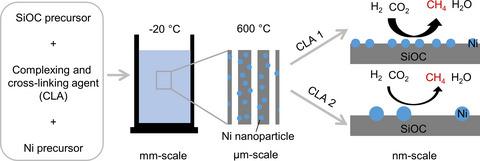当前位置:
X-MOL 学术
›
J. Am. Ceram. Soc.
›
论文详情
Our official English website, www.x-mol.net, welcomes your
feedback! (Note: you will need to create a separate account there.)
Porous SiOC monoliths with catalytic activity by in situ formation of Ni nanoparticles in solution‐based freeze casting
Journal of the American Ceramic Society ( IF 3.5 ) Pub Date : 2020-01-10 , DOI: 10.1111/jace.16988 Daniel Schumacher 1 , Michaela Wilhelm 1 , Kurosch Rezwan 1, 2
Journal of the American Ceramic Society ( IF 3.5 ) Pub Date : 2020-01-10 , DOI: 10.1111/jace.16988 Daniel Schumacher 1 , Michaela Wilhelm 1 , Kurosch Rezwan 1, 2
Affiliation

|
Micro‐ and macroporous monoliths with in situ formed nickel nanoparticles were prepared for the first time by the combination of solution‐based freeze casting and preceramic polymers (methyl polysiloxane). This one‐step process results in macroporous monoliths composed of microporous and catalytic active nickel‐containing polymer‐derived ceramic. Four different complexing and cross‐linking siloxanes with amino functionality were screened for their ability to create small nickel particles. TEM analysis confirmed 3‐aminopropyltriethoxysilane being most efficient. High BET‐specific surface areas of 344‐461 m2 g−1 were achieved. Increased ratio of complexing groups to nickel improves the dispersion of nickel to (3.61 ± 1.49) nm. The nickel size dependence of conversion (maximum 0.49) and CH4 selectivity (maximum 0.74) in CO2 methanation emphasizes the importance of controlling the nickel size. The hydrophobic surface characteristic is hypothesized to be the main reason polymer‐derived catalysts having better catalytic activity compared with nickel‐impregnated silica. The promising catalytic activity combined with the versatile freeze casting process can prospectively address heat‐ and mass‐transfer considerations in heterogeneous monolith catalysis.
中文翻译:

通过在溶液基冷冻铸造中原位形成镍纳米颗粒而具有催化活性的多孔SiOC单块
通过基于溶液的冷冻浇铸和陶瓷前聚合物(甲基聚硅氧烷)的组合,首次制备了具有原位形成的镍纳米粒子的微孔和大孔整料。这一一步过程导致了由微孔催化活性含镍聚合物衍生的陶瓷组成的大孔整料。筛选了具有氨基官能团的四种不同的配位和交联硅氧烷,它们具有产生镍小颗粒的能力。TEM分析证实3-氨基丙基三乙氧基硅烷是最有效的。高BET比表面积344-461 m 2 g -1实现了。络合基团与镍的比率增加,使镍的分散度提高到(3.61±1.49)nm。在CO 2甲烷化中镍的转化率依赖性(最大0.49)和CH 4选择性(最大0.74)强调了控制镍大小的重要性。疏水表面特性被认为是聚合物衍生的催化剂比镍浸渍的二氧化硅具有更好的催化活性的主要原因。具有前途的催化活性与通用的冷冻浇铸工艺相结合,可以在非均相整体催化中解决传热和传质方面的问题。
更新日期:2020-01-11
中文翻译:

通过在溶液基冷冻铸造中原位形成镍纳米颗粒而具有催化活性的多孔SiOC单块
通过基于溶液的冷冻浇铸和陶瓷前聚合物(甲基聚硅氧烷)的组合,首次制备了具有原位形成的镍纳米粒子的微孔和大孔整料。这一一步过程导致了由微孔催化活性含镍聚合物衍生的陶瓷组成的大孔整料。筛选了具有氨基官能团的四种不同的配位和交联硅氧烷,它们具有产生镍小颗粒的能力。TEM分析证实3-氨基丙基三乙氧基硅烷是最有效的。高BET比表面积344-461 m 2 g -1实现了。络合基团与镍的比率增加,使镍的分散度提高到(3.61±1.49)nm。在CO 2甲烷化中镍的转化率依赖性(最大0.49)和CH 4选择性(最大0.74)强调了控制镍大小的重要性。疏水表面特性被认为是聚合物衍生的催化剂比镍浸渍的二氧化硅具有更好的催化活性的主要原因。具有前途的催化活性与通用的冷冻浇铸工艺相结合,可以在非均相整体催化中解决传热和传质方面的问题。











































 京公网安备 11010802027423号
京公网安备 11010802027423号